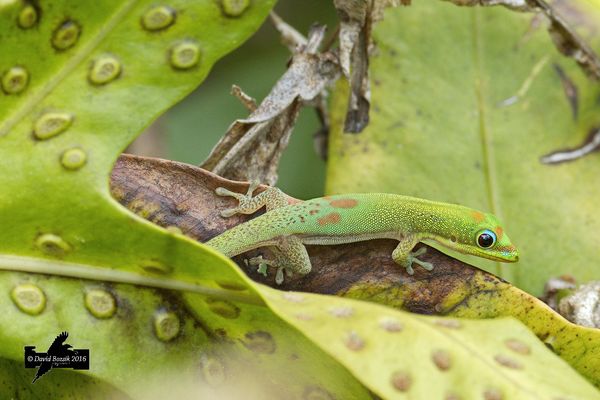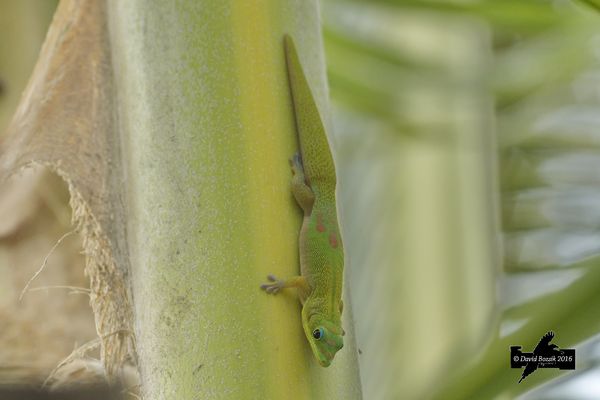How to capture Gold in the Sandwich Islands
Oct 17, 2016 19:11:38 #
Thought you might find this useful. Enjoy. There are more articles on capturing wildife on my blog site and this forum. Enjoy.
I just returned from a recent visit to the Sandwich islands. For those of you who have no knowledge of this name, no bells going off in the head, these are the Hawaiian Islands. Named by Captain James Cook for a colleague of his at the time.
This blog, will be targeting a very specific subject - the Gold Dust Gecko (Phelsuma laticauda) (GDG). While this lizard is not the fanciful insurance sales rep you might want it to be, they provide a wonderful and beautiful subject in front of the camera lens.
The GDG is now a common resident of the Islands. Like many of us, it is not a native species, but was introduced from Madagascar many moons ago. Many, and I would venture to say, most geckos, are nocturnal. That means, they prefer to be most active after the sun disappears each day to recharge for the following morning's light.
You are probably asking why I would spend a blog on techniques for shooting this subject. Well, once you view a couple of the images, you will probably want to plan your next trip to Hawaii with the sole intent to capture images of this outstanding and beautiful creature.
If you have spent any time shooting wildlife, you have figured out that researching the animal plays a major role in locating and setting up for shooting a specific species. The GDG is diurnal. It is out and about in the daylight hours. But how do you know if they are in the area you are shooting?
GDG, like many geckos, have the habit of hanging around outdoor lights at night - just like many of the other nocturnal gecko species. This preference provides you with the opportunity to locate lizards during the day as well. Instead of sitting in front of the TV screen in the condo or hotel you are visiting, dusk will be the time for you to do your scouting. Yes, this does mean you may miss your favorite sitcom, ball game, etc. but you only live once, right? I say, "Watch the re-runs".
Anyway, you will want to find places where the lights illuminate the side of a wall. This attracts insects, which in turn are the food for your lizard photo friends. If you wander, stay out until it is very dark as some of the lizards have realized they don't survive predator attacks if it is still light outside - it is a sharp learning curve here.
If you don't locate any lizards, keep searching. Make sure there are plants around as well as a wall with a light. They require a place to hide, and the foliage is a perfect one for them. If you spot one or two you are on your way to the next step. The following morning, when it is light, grab your camera and tripod and head back down to the location of the previous night's sighting. These subjects are bright green, so your next step is to find them in the bushes nearby the place you located them the previous night.
DON'T "Beat the bushes", in an attempt to flush them out. This is why I said bring a tripod. I was able to locate the lizards after waiting approximately 20-30 minutes. If you are still, you will notice them moving from one leaf to another. If you are moving around searching for them, chances are they will spot you first, and the game is over - that is until you decide to use your most useful tool...knowing that lizards have short memories. This means if you are motionless for a while, they forget that you were close by.
When choosing plants to stand near, or alongside, flowering trees such as plumeria or palms with blossoms are a good choice. You will notice in one of my captures (see below), the gecko was taking nectar from the blossoms. Yes, this species feed on nectar, just like hummingbirds, and bees. So you should find nearby trees that are providing this energy source for your lizard shooting.
Now, for the equipment you will need to make your captures. If you are the stealthy, patient type of individual, you will not need a lens longer than 200mm. Athough I was using the 80-400mm lens, it was not a "have to have" deal. It enabled me to shoot sooner than if I had used the shorter lens.
Noise is not an issue with these critters, athough when you are up closer with the shorter lens, movement will be. Remember, these lizards are eating small insects hidden among the foliage. They can, for certain, spot you if you can't keep still.
When you locate one, just stop and watch it for a while. If it moves behind a leaf, you can shift a bit closer. Try to anticipate where the lizard is heading - are there some blossoms on the next branch over, or an insect twitching its wings or cleaning its appendages that has caught the eye of the lizard? This is how you set up the ambush.
If you are using a long lens or zoom, the tripod will help a lot. I try to use a faster shutter speed, so sometimes the ISO is pretty high. I think some of these shots were at ISO 1000 or higher. If you have an abundant light source, you can choose to lower the ISO.
Camera gear is not super important, though the better gear can sometimes capture better shots. I have seen some images of this animal captured on cell phones. The important ingredient here is stealth and patience.
Now the next time you travel to the islands that captain Cook named after his buddy, you will want to hang out near the shrubbery and "give the geckos a go".
I just returned from a recent visit to the Sandwich islands. For those of you who have no knowledge of this name, no bells going off in the head, these are the Hawaiian Islands. Named by Captain James Cook for a colleague of his at the time.
This blog, will be targeting a very specific subject - the Gold Dust Gecko (Phelsuma laticauda) (GDG). While this lizard is not the fanciful insurance sales rep you might want it to be, they provide a wonderful and beautiful subject in front of the camera lens.
The GDG is now a common resident of the Islands. Like many of us, it is not a native species, but was introduced from Madagascar many moons ago. Many, and I would venture to say, most geckos, are nocturnal. That means, they prefer to be most active after the sun disappears each day to recharge for the following morning's light.
You are probably asking why I would spend a blog on techniques for shooting this subject. Well, once you view a couple of the images, you will probably want to plan your next trip to Hawaii with the sole intent to capture images of this outstanding and beautiful creature.
If you have spent any time shooting wildlife, you have figured out that researching the animal plays a major role in locating and setting up for shooting a specific species. The GDG is diurnal. It is out and about in the daylight hours. But how do you know if they are in the area you are shooting?
GDG, like many geckos, have the habit of hanging around outdoor lights at night - just like many of the other nocturnal gecko species. This preference provides you with the opportunity to locate lizards during the day as well. Instead of sitting in front of the TV screen in the condo or hotel you are visiting, dusk will be the time for you to do your scouting. Yes, this does mean you may miss your favorite sitcom, ball game, etc. but you only live once, right? I say, "Watch the re-runs".
Anyway, you will want to find places where the lights illuminate the side of a wall. This attracts insects, which in turn are the food for your lizard photo friends. If you wander, stay out until it is very dark as some of the lizards have realized they don't survive predator attacks if it is still light outside - it is a sharp learning curve here.
If you don't locate any lizards, keep searching. Make sure there are plants around as well as a wall with a light. They require a place to hide, and the foliage is a perfect one for them. If you spot one or two you are on your way to the next step. The following morning, when it is light, grab your camera and tripod and head back down to the location of the previous night's sighting. These subjects are bright green, so your next step is to find them in the bushes nearby the place you located them the previous night.
DON'T "Beat the bushes", in an attempt to flush them out. This is why I said bring a tripod. I was able to locate the lizards after waiting approximately 20-30 minutes. If you are still, you will notice them moving from one leaf to another. If you are moving around searching for them, chances are they will spot you first, and the game is over - that is until you decide to use your most useful tool...knowing that lizards have short memories. This means if you are motionless for a while, they forget that you were close by.
When choosing plants to stand near, or alongside, flowering trees such as plumeria or palms with blossoms are a good choice. You will notice in one of my captures (see below), the gecko was taking nectar from the blossoms. Yes, this species feed on nectar, just like hummingbirds, and bees. So you should find nearby trees that are providing this energy source for your lizard shooting.
Now, for the equipment you will need to make your captures. If you are the stealthy, patient type of individual, you will not need a lens longer than 200mm. Athough I was using the 80-400mm lens, it was not a "have to have" deal. It enabled me to shoot sooner than if I had used the shorter lens.
Noise is not an issue with these critters, athough when you are up closer with the shorter lens, movement will be. Remember, these lizards are eating small insects hidden among the foliage. They can, for certain, spot you if you can't keep still.
When you locate one, just stop and watch it for a while. If it moves behind a leaf, you can shift a bit closer. Try to anticipate where the lizard is heading - are there some blossoms on the next branch over, or an insect twitching its wings or cleaning its appendages that has caught the eye of the lizard? This is how you set up the ambush.
If you are using a long lens or zoom, the tripod will help a lot. I try to use a faster shutter speed, so sometimes the ISO is pretty high. I think some of these shots were at ISO 1000 or higher. If you have an abundant light source, you can choose to lower the ISO.
Camera gear is not super important, though the better gear can sometimes capture better shots. I have seen some images of this animal captured on cell phones. The important ingredient here is stealth and patience.
Now the next time you travel to the islands that captain Cook named after his buddy, you will want to hang out near the shrubbery and "give the geckos a go".
Oct 17, 2016 19:17:16 #
Oct 17, 2016 19:37:17 #
Oct 18, 2016 01:00:47 #
What a wonderful, educational post, David. I don't plan to travel to Hawaii in the near future, but it seems your instructions would be helpful in capturing many different kinds of critters. We have the Mediterranean geckos, and I've yet to get a good shot of one, since they're nocturnal and very shy.
Oct 18, 2016 01:52:04 #
Dixiegirl wrote:
What a wonderful, educational post, David. I don't plan to travel to Hawaii in the near future, but it seems your instructions would be helpful in capturing many different kinds of critters. We have the Mediterranean geckos, and I've yet to get a good shot of one, since they're nocturnal and very shy.
I know a lot of the members have visited, and will visit the islands again, so I thought this would help.
Oct 18, 2016 06:01:06 #
Bozsik wrote:
Thought you might find this useful. Enjoy. There a... (show quote)
Student to teacher, David, you did it again. Excellent photos and the preamble is fantastic. Thank you again.
Greg
Oct 18, 2016 06:07:44 #
Super photos, David, & thanks for the wealth of information that you are sharing. I'm sure it will be much appreciated. 







Oct 18, 2016 06:19:31 #
Oct 18, 2016 07:23:38 #
Oct 18, 2016 07:35:10 #
Fantastic series on a beautiful creature and your narrative is really helpful.
Oct 18, 2016 10:54:04 #
Oct 18, 2016 11:39:07 #
Bozsik wrote:
Thought you might find this useful. Enjoy. There a... (show quote)
You did an excellent job on these and #5 is my favorite....Rich
Oct 18, 2016 11:45:04 #
Thank you all. I have been wanting to share info in one of the areas of this forum for some time, but I didn't want to come off as a "know all". I have basic skills that I have developed over the past and thought some others might gain from the info. If it has helped or entertained even one, I am relieved.
Oct 18, 2016 12:23:24 #
A handsome bugger! And you have displayed them at their very best!
Thanks for sharing!
Bob
Thanks for sharing!
Bob
Oct 18, 2016 13:35:37 #
If you want to reply, then register here. Registration is free and your account is created instantly, so you can post right away.

















